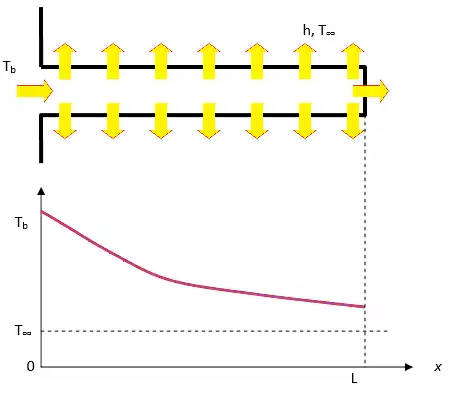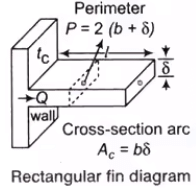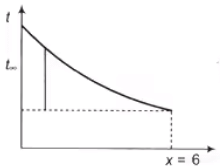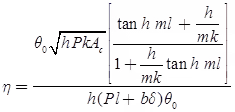Mechanical Engineering Exam > Mechanical Engineering Notes > Heat Transfer > Heat Transfer Through Fins
Heat Transfer Through Fins | Heat Transfer - Mechanical Engineering PDF Download
Heat Transfer from Extended Surface (Fin)
- A fin is a surface that extends from an object to increase the rate of heat transfer to or from the environment by increase convection.
- Adding a fin to an object increases the surface area and can sometimes be an economical solution to heat transfer problems.
- Finned surfaces are commonly used in practice to enhance heat transfer. In the analysis of the fins, we consider steady operation with no heat generation in the fin.
- We also assume that the convection heat transfer coefficient h to be constant and uniform over the entire surface of the fin.

- The rate of heat transfer from a solid surface to atmosphere is given by Q = hA ∆ T where, h and ∆T are not controllable.
- So, to increase the value of Q surface area should be increased. The extended surface which increases the rate of heat transfer is known as fin.
Generalized Equation for Fin Rectangular Fin

Where Ac and As are cross-sectional and surface area:
And θ(x) = t(x)–ta

Heat balance equation if Ac constant and As ∞ P(x) linear:
- General equation of 2nd order: θ = c1emx + c2e–mx
- Heat dissipation can take place on the basis of three cases.
Case 1: Heat Dissipation from an Infinitely Long Fin (l → ∞):
- In such a case, the temperature at the end of Fin approaches to surrounding fluid temperature ta as shown in figure. The boundary conditions are given below
- At x = 0, t = t0 : θ = t0 – ta = θ0
- At x = L→ ∞: t = ta, θ = 0

θ = θ0 e–mx

- Heat transfer by conduction at base:

Case 2: Heat Dissipation from a Fin Insulated at the End Tip:
- Practically, the heat loss from the long and thin film tip is negligible, thus the end of the tip can be, considered as insulated.
- At x = 0, t = t0 and θ = t0 – ta = θ0
at x = l , Q = 0 i.e, dθ/dx = 0


Case 3: Heat Dissipation from a Fin loosing Heat at the End Tip:
- The boundary conditions are given below.
- At x = 0, t = t0 and θ = θ0
- At x = l
Qconduction = Qconvection

Fin Efficiency
Fin efficiency is given by:
- If l → ∞ (infinite length of fin):

- If fin is with insulated tip:

- If finite length of fin:

Note: The following must be noted for a proper fin selection:
- The longer the fin, the larger the heat transfer area and thus the higher the rate of heat transfer from the fin.
- The larger the fin, the bigger the mass, the higher the price, and larger the fluid friction.
- The fin efficiency decreases with increasing fin length because of the decrease in fin temperature with length.
Fin Effectiveness
- The performance of fins is judged on the basis of the enhancement in heat transfer relative to the no‐fin case, and expressed in terms of the fin effectiveness:

- For a sufficiently long fin of uniform cross‐section Ac, the temperature at the tip of the fin will approach the environment temperature, T∞. By writing energy balance and solving the differential equation, one finds:


where Ac is the cross‐sectional area, x is the distance from the base, and p is perimeter. The effectiveness becomes:
To increase fins effectiveness, one can conclude:
- The thermal conductivity of the fin material must be as high as possible
- The ratio of perimeter to the cross‐sectional area p/Ac should be as high as possible
- The use of fin is most effective in applications that involve low convection heat transfer coefficient, i.e. natural convection.
The document Heat Transfer Through Fins | Heat Transfer - Mechanical Engineering is a part of the Mechanical Engineering Course Heat Transfer.
All you need of Mechanical Engineering at this link: Mechanical Engineering
|
59 videos|108 docs|86 tests
|
FAQs on Heat Transfer Through Fins - Heat Transfer - Mechanical Engineering
| 1. What is heat transfer through fins? |  |
Heat transfer through fins refers to the process of transferring heat from a solid surface to the surrounding fluid through the use of extended surfaces called fins. Fins are commonly used in various engineering applications, such as heat exchangers, radiators, and electronic cooling systems, to enhance heat transfer efficiency.
| 2. How do fins improve heat transfer? |  |
Fins improve heat transfer by increasing the surface area available for heat exchange. The extended surface area of the fins allows for a larger contact area between the solid surface and the fluid, enabling more efficient heat transfer. Fins also help in increasing the convective heat transfer coefficient, which enhances the overall heat transfer rate.
| 3. What factors affect heat transfer through fins? |  |
Several factors influence heat transfer through fins, including:
- Fin geometry: The shape, size, and arrangement of the fins impact the heat transfer rate. Fins with larger surface areas and appropriate spacing tend to have better heat transfer performance.
- Material properties: The thermal conductivity and thickness of the fin material affect how well heat is conducted through the fins.
- Fluid properties: The convective heat transfer coefficient of the fluid, its velocity, and temperature play a crucial role in determining heat transfer through fins.
- Temperature difference: The temperature gradient between the solid surface and the fluid affects the heat transfer rate. A larger temperature difference typically results in higher heat transfer rates.
| 4. How can the effectiveness of fins be evaluated? |  |
The effectiveness of fins can be evaluated using different performance parameters, such as fin efficiency and effectiveness. Fin efficiency represents the ratio of actual heat transfer with fins to the maximum possible heat transfer without fins. It takes into account factors like fin geometry and material properties. On the other hand, fin effectiveness compares the actual heat transfer rate with fins to the heat transfer rate that would occur with an infinite number of fins. It provides a measure of how well the fins are performing in enhancing heat transfer.
| 5. What are some common types of fins used in heat transfer applications? |  |
There are several types of fins commonly used in heat transfer applications, including:
- Rectangular fins: These fins have a rectangular cross-section and are widely used due to their simplicity and ease of manufacturing.
- Circular fins: Circular fins have a circular cross-section and are often used in applications where space is limited or when a more uniform heat transfer distribution is desired.
- Annular fins: Annular fins have a cylindrical shape with a hollow center. They are used in applications where heat transfer needs to occur across cylindrical surfaces, such as in heat exchangers.
- Pin fins: Pin fins are thin, elongated fins that resemble small pins. They are commonly used in electronic cooling systems to maximize surface area while minimizing pressure drop.
Related Searches
















